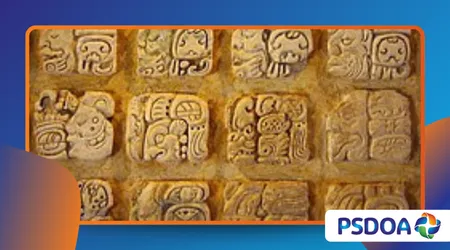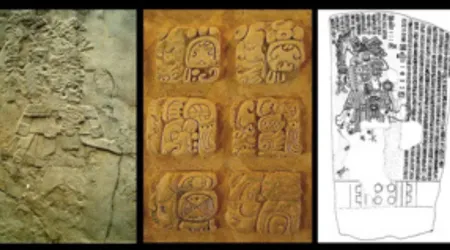The Forgotten Logograms of the Olmec Civilization

Forgotten Logograms of the Olmec Civilization stand as one of archaeology’s most tantalizing unsolved mysteries, representing what is potentially the earliest writing system in the Americas, centuries preceding the famous Maya script.
Anúncios
This sophisticated network of symbols, often carved into stone, offers a window into the intellectual prowess of Mesoamerica’s “mother culture,” which flourished along Mexico’s Gulf Coast from roughly 1500 BCE to 400 BCE.
Unlocking this ancient script is not merely an academic exercise; it promises to completely rewrite our understanding of early state formation, social hierarchy, and the transmission of knowledge across ancient North America.
The scarcity and fragmentation of recovered texts have significantly hampered decipherment efforts, leaving scholars in an ongoing.
Passionate debate: do these glyphs constitute a true system capable of encoding language, or are they elaborate proto-writing a powerful set of symbols?
Anúncios
The sheer complexity and systematic repetition of the signs, particularly those found on the highly debated Cascajal Block, strongly argue for a formalized method of communication.
The enduring enigma of the Forgotten Logograms of the Olmec Civilization compels us to continually search for new clues, knowing that an entire lost history awaits revelation within these enigmatic carvings.
What is the Cascajal Block and Why is it Central to the Debate?
When Was the Cascajal Block Discovered and What Does it Contain?
The Cascajal Block, a tablet-sized serpentinite slab, was discovered by local road builders in the late 1990s in the Olmec heartland near San Lorenzo Tenochtitlán, but its significance wasn’t recognized until 2006.
The block is dated by the associated ceramic shards to the San Lorenzo phase, around 900 BCE, positioning its inscription at least four centuries before the oldest known Zapotec writing.
This artifact is crucial because it contains 62 incised signs, of which 28 are distinct, arranged in linear patterns, a critical feature of true writing.
Some logograms resemble natural objects like maize, insects, and fish while others are abstract boxes or geometric shapes, providing a direct glimpse into the structural complexity of the Forgotten Logograms of the Olmec Civilization.
++ When Wind Power Was the Future — In 1930
Why Do Scholars Disagree on Whether the Block is True Writing?
While proponents like archaeologist Stephen Houston view the block’s patterns and sign repetition as definitive proof of syntax, indicating a true writing system, skepticism remains.
Critics argue that the symbols are unlike those in any later Mesoamerican scripts and lack the consistent overall organization expected of a linguistic text.
The primary point of contention revolves around the text’s apparent horizontal arrangement and lack of vertical columns, which is typical of later Mayan or Zapotec scripts.
Furthermore, some archaeologists interpret the signs as a pictographic arrangement of ritualistic objects or emblems used in divination.
Rather than a system designed to fully encode spoken language, leaving the meaning of the Forgotten Logograms of the Olmec Civilization unresolved.

How Did Olmec Glyphs Influence Later Mesoamerican Scripts?
Why is the Olmec Civilization Considered the “Mother Culture”?
The Olmec civilization, existing centuries before the Maya and Aztecs, is widely recognized as the foundational culture that established many of Mesoamerica’s core cultural and intellectual traditions.
Their innovations spanned monumental architecture (the colossal heads), shared religious iconography (the were-jaguar motif), and, crucially, a highly advanced calendar system.
Elements of the Olmec calendrical system, including the use of dots and bars for numerical representation and potentially the 260-day sacred calendar, were directly adopted and refined by subsequent civilizations.
The complexity visible in the Forgotten Logograms of the Olmec Civilization suggests they pioneered the fundamental concept of script that others, including the Maya, would later evolve into a full logosyllabic system.
Also read: The 8-Track Tape: Why It Rose Fast and Fell Faster
What Specific Signs Show Continuity with the Maya Script?
Despite the overall dissimilarity of the Cascajal Block script to later forms, specific examples of Olmec logographic use hint at a foundational connection to the Maya system.
Artifacts from San Andrés, dated to 650 BCE, feature glyphs that scholars interpret as logograms for a calendrical day name and the word for “king” (ajaw), written using the bar-and-dot numeration.
This early evidence of combining logograms with calendrical and royal titles shows the development of a script utilized for state propaganda and chronology, a function perfectly mirrored in later Maya stelae.
The transition from the powerful, concise Forgotten Logograms of the Olmec Civilization to the fully expressive Maya hieroglyphs represents a clear evolutionary path in Mesoamerican literacy.
Read more: How Vacuum Trains Were Almost a Reality in the 1800s
Why Does the Decipherment of Olmec Writing Matter Today?
What Does the Undeciphered Script Prevent Us from Knowing?
The inability to read the Forgotten Logograms of the Olmec Civilization leaves a vast chasm in our knowledge of Mesoamerican history, especially regarding the earliest societal structures.
We lack primary source documentation about their political organizations, religious beliefs, and the names and achievements of the rulers who commissioned the colossal stone heads.
Imagine studying Ancient Egypt without the Rosetta Stone; that is the current reality for Olmec studies.
Decipherment would reveal details about their trade networks, their understanding of astronomy, and the specific language (likely an ancestral Mixe-Zoquean language).
They spoke, transforming a mysterious, largely iconographic culture into a documented historical state.
Analogical Insight: The Rosetta Stone of Mesoamerica
The search for the key to decipher the Olmec script is best understood through the analogy of the Rosetta Stone.
The Rosetta Stone worked because it contained the same decree written in three scripts: Egyptian hieroglyphs, Demotic script, and Ancient Greek (a known language).
To break the code of the Forgotten Logograms of the Olmec Civilization, archaeologists need a similar bilingual or trilingual inscription.
This ‘Olmec Rosetta Stone’ would need to contain the Olmec script alongside an early, readable version of the Maya or Isthmian script, or perhaps a depiction and corresponding name for a known ruler or historical event, which remains undiscovered in 2025.
The Administrative Function of Olmec Logograms
If deciphered, the logograms could confirm that the Olmecs used writing for complex bureaucratic and administrative tasks, similar to later urban centers.
For instance, a repeating abstract logogram might denote ‘tribute’ or ‘taxation’ from a subject settlement, confirming an early, formalized state economy.
This would demonstrate that writing’s function extended beyond mere ritualistic display, cementing the Olmecs’ organizational sophistication.
The Transmission of Religious Narratives
The logograms likely encode creation myths or ritual sequences, as suggested by their appearance on small, personal artifacts like seals.
A logogram frequently repeated with the were-jaguar motif might represent a specific deity’s name or a sacred invocation.
Understanding these symbols would immediately unlock the deepest religious narratives of the Olmec, showing how the Forgotten Logograms of the Olmec Civilization preserved the cosmology that influenced the beliefs of the Aztecs and Maya.
What is the Current Status of Archaeological Research on Olmec Writing in 2025?
Research in 2025 remains highly focused on finding new inscriptions and conducting detailed distributional analysis of the existing signs on the Cascajal Block and related artifacts.
Recent analysis, utilizing advanced imaging techniques, seeks to confirm whether certain signs function as logograms (representing whole words) or as phonograms (representing sounds), a common feature in many Mesoamerican scripts.
The debate is now less about if the Olmecs had writing, and more about the structure of their script and the linguistic family it encoded.
| Artifact/Site | Approximate Date (BCE) | Key Logographic Evidence | Scholarly Consensus |
| Cascajal Block | 900 | 62 distinct incised signs in linear arrangement. | Disputed (True writing vs. Proto-writing) |
| San Andrés Cylinder Seal | 650 | Bird with speech scrolls, ‘3 Ajaw’ glyph. | Evidence for calendrical and royal logograms |
| La Venta Monument 13 | 600-400 | Short inscription, possibly an early date. | Links Olmec to calendar notation |
Conclusion: The Unwritten Chapter of the Olmec
The Forgotten Logograms of the Olmec Civilization represent a powerful, yet silent, testament to the intellectual flowering of the Pre-Columbian world.
The evidence, though sparse, overwhelmingly points to a people who established the foundations of Mesoamerican high culture, including the principles of written communication.
Until a longer, definitive inscription is unearthed our metaphorical Olmec Rosetta Stone their full story remains largely an unwritten chapter, forcing us to rely on monumental art and the archaeological record.
The ongoing research serves as a critical, necessary effort to give voice to the continent’s earliest literary pioneers.
Do you believe the Cascajal Block represents true language or a system of ritualistic symbols, and why? Share your insights and theories below!
Frequently Asked Questions (FAQ)
What is a Logogram?
A logogram is a single written character that represents a complete word or morpheme (a meaningful unit of language).
For example, the ‘&’ sign is a logogram for ‘and.’ The Olmec script is hypothesized to be primarily logographic.
Is the Olmec Script the Oldest in the Americas?
The inscription on the Cascajal Block (c. 900 BCE) is currently argued by many scholars to be the oldest known writing system in the Americas, predating early Zapotec inscriptions (c. 500 BCE) and the earliest confirmed Maya script.
What Language Did the Olmecs Speak?
Archaeologists and linguists generally agree that the Olmecs likely spoke an ancestral form of the Mixe-Zoquean language family.
Attempts to phonetically decipher the Olmec script often look for patterns consistent with this ancient language family.
Why haven’t the Olmec Logograms been fully deciphered?
The primary obstacle is the lack of text length.
Unlike the Maya, whose inscriptions are numerous and long, the Olmec evidence is limited to short sequences, isolated glyphs, and the single, unique Cascajal Block.
Without redundant examples or a bilingual text, identifying phonetic values is nearly impossible.
What are the Olmec Colossal Heads?
The Colossal Heads are monumental stone sculptures, often up to three meters tall, depicting the portraits of powerful Olmec rulers, characterized by distinctive helmets and individualized facial features.
They are an iconographic link to the elite who likely used the logograms.
